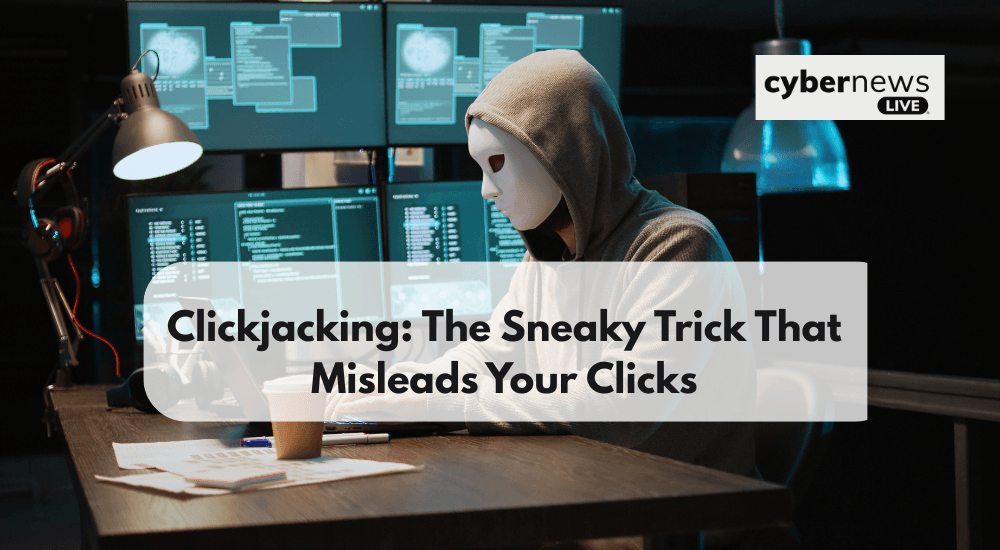
Clickjacking: The Sneaky Trick That Misleads Your Clicks
Clickjacking is a malicious technique that deceives users into interacting with a webpage interface that is either invisible or disguised as a legitimate component. This deceptive interaction can result in the user unknowingly performing unintended actions, such as downloading malicious software, navigating harmful websites, or disclosing sensitive personal information or credentials. The user might believe they are clicking a legitimate element, such as a button or link, when in fact, they are interacting with something hidden. This form of attack can have severe consequences. For example, the user may inadvertently authorize a financial transaction or unknowingly grant permission to a malicious actor to access their personal information.
Let’s explore clickjacking in more detail.
How Does a Clickjacking Attack Work?

The mechanism behind clickjacking is simple, but the attack can be highly sophisticated. Attackers may use various techniques to deceive users and execute their malicious intent.
Here’s how it typically works:
Crafting the Trap Page
The first step in a clickjacking attack involves the attacker embedding a legitimate website into their malicious webpage. This is usually done using an HTML (<iframe>) element, which allows one web page to be displayed inside another. For example, an attacker might embed a user’s online banking site, social media profile, or shopping cart checkout page into their site using an iframe. However, attackers make the iframe either fully transparent or partially visible, depending on their goal.
Layering a Fake UI (Deception)
The attacker sets a trap for the user by making a fake interface (such as a fake “Play” button or a fake download link) appear harmless and enticing. The user interface might look identical to a legitimate one. Such tactics often promise rewards like prizes, discounts, or exclusive content. These fake elements prompt users to engage with the malicious interface. However, they are strategically aligned with interactive elements in the invisible iframe underneath, such as a “Submit Payment” button or a “Confirm Purchase” link. As a result, when the user clicks what appears to be a harmless button, they’re actually triggering a hidden, often dangerous action.
Execution of the Malicious Action
At this stage of the attack, the malicious action is executed. When the user clicks on what they believe is a legitimate element, their click interacts with the hidden iframe underneath. This hidden iframe might trigger an action such as posting on social media, approving a payment, or executing a malicious script.
How to Prevent Clickjacking?
Clickjacking is a sophisticated web attack with potentially serious consequences if not mitigated. Due to its potentially harmful effects, organizations must implement robust security measures. Below are key preventive measures to protect against clickjacking attacks:
Use Security Headers
The HTTP response header is one of the most fundamental and practical ways to prevent clickjacking. It instructs browsers to block other websites from embedding your site in a frame. The X-Frame-Options header is a traditional method widely supported by browsers. It can be set to DENY, which completely blocks any domain from framing your site, or SAMEORIGIN, which allows framing only if the request comes from the same source.
Use Content Security Policy (CSP)
The Content Security Policy (CSP), specifically the frame-ancestors directive, is a more modern and robust approach than X-Frame-Options. This allows for fine-grained control over which sources (domains) can embed your site in frames. Specifically, using the frame-ancestors directive in a CSP allows you to control which domains (if any) can embed your pages, effectively blocking unauthorized framing.
Look for Visual Cues
Clickjacking attacks often rely on deceptive or misleading user interface designs. Users should be attentive to visual cues indicating a compromised page, such as overly simplistic layouts, awkward formatting, or huge buttons or links. These design elements may be intended to obscure or overlay other functional elements on the page. If a webpage appears visually suspicious, users should exercise caution and avoid clicking on any elements until the site’s legitimacy can be verified.
Use Browser Extensions for Protection
Installing browser extensions specifically designed to detect and block clickjacking attempts can provide an additional layer of security. These tools can identify transparent iframes, overlapping elements, and other forms of suspicious layering used in such attacks. Extensions like NoScript for Firefox or ScriptSafe for Chrome help limit the execution of untrusted scripts and protect users from interacting with deceptive content. Employing such extensions is a practical way to reinforce browser-based defenses.
Educate Developers and Users
Finally, it’s crucial to foster clickjacking awareness among developers and users. Developers should be trained to implement secure design patterns, avoid embedding sensitive functionality in iframes, and regularly audit their applications for UI vulnerabilities. On the user side, educating them about signs of suspicious behavior, such as unexpected pop-ups or strange redirects, can help them avoid falling victim to the social engineering aspects of clickjacking. Bug bounty programs and feedback tools can also surface vulnerabilities. These mechanisms encourage ethical hackers and researchers to report security flaws.
Conclusion
Clickjacking is a deceptive and dangerous attack that exploits the visual nature of the web. While it might seem like a niche threat, its potential for harm, from minor annoyances to significant financial losses and privacy breaches, makes it a serious concern. By deepening our understanding of how clickjacking works and combining vigilant user behavior with strong developer-side security measures, we can work together to create a safer, more trustworthy internet.
Don’t let cybercriminals outsmart you. Follow Cyber News Live for real-time alerts, expert insights, and the latest cybersecurity news delivered straight to your inbox.

